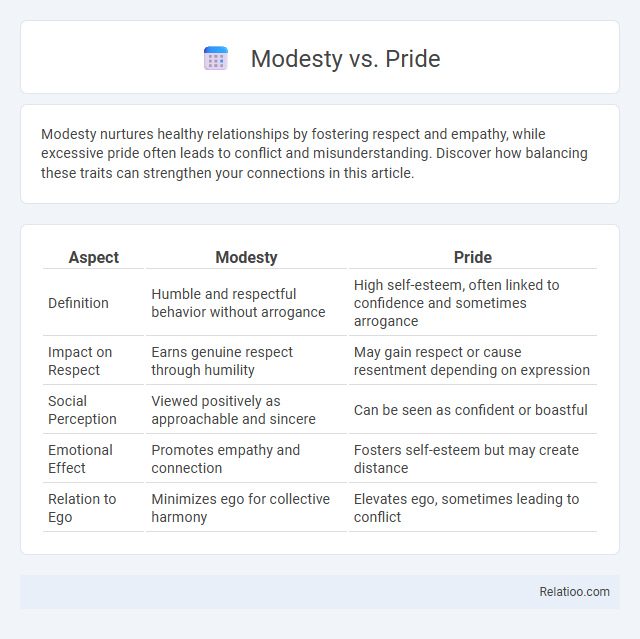Modesty nurtures healthy relationships by fostering respect and empathy, while excessive pride often leads to conflict and misunderstanding. Discover how balancing these traits can strengthen your connections in this article.
Table of Comparison
| Aspect | Modesty | Pride |
|---|---|---|
| Definition | Humble and respectful behavior without arrogance | High self-esteem, often linked to confidence and sometimes arrogance |
| Impact on Respect | Earns genuine respect through humility | May gain respect or cause resentment depending on expression |
| Social Perception | Viewed positively as approachable and sincere | Can be seen as confident or boastful |
| Emotional Effect | Promotes empathy and connection | Fosters self-esteem but may create distance |
| Relation to Ego | Minimizes ego for collective harmony | Elevates ego, sometimes leading to conflict |
Understanding the Essence of Modesty
Modesty embodies humility and self-restraint, reflecting an authentic appreciation for one's abilities without exaggeration. Pride often implies an inflated sense of self-worth, whereas true modesty involves balanced self-awareness and respect for others. Understanding the essence of modesty promotes genuine confidence grounded in sincerity rather than external validation.
Defining the Nature of Pride
Pride is characterized by an inflated sense of self-worth and confidence, often leading to arrogance or superiority over others, which contrasts sharply with modesty's humble and unassuming nature. Modesty emphasizes restraint and a realistic appraisal of one's abilities, while pride prioritizes self-glorification and recognition. Understanding pride involves recognizing its potential to foster both positive self-esteem and negative egotism, depending on its expression and context.
Historical Perspectives on Modesty and Pride
Historical perspectives on modesty often depict it as a virtue aligned with humility, social harmony, and moral discipline, especially in religious and cultural traditions such as Christianity and Confucianism. Pride, historically, is frequently viewed in dual terms: as a positive source of self-respect and achievement in ancient Greek philosophy, but also as a vice linked to hubris and downfall in biblical teachings. The interplay between modesty and pride reflects evolving societal values where modesty emphasizes restraint and community cohesion, whereas pride asserts individual identity and accomplishment.
The Role of Modesty in Personal Growth
Modesty fosters personal growth by encouraging self-awareness and openness to constructive feedback, which helps individuals recognize their limitations and areas for improvement. Unlike pride, which can create barriers through overconfidence and defensiveness, modesty cultivates humility and a willingness to learn from others. This attitude promotes continuous development and stronger interpersonal relationships by valuing truth over ego.
How Pride Shapes Self-Perception
Pride significantly influences how you perceive yourself by fostering a strong sense of confidence and self-worth, which can motivate personal growth and achievement. However, excessive pride may distort self-perception, leading to arrogance and an inflated ego that hinders genuine self-awareness. In contrast, modesty promotes a balanced and humble self-view, allowing for continuous learning and meaningful connections with others.
Cultural Interpretations of Modesty and Pride
Cultural interpretations of modesty and pride vary significantly across societies, shaping behavioral norms and social expectations. In many Eastern cultures, modesty is revered as a virtue reflecting humility and social harmony, whereas Western contexts may emphasize pride as a symbol of personal achievement and confidence. Understanding these cultural nuances helps you navigate social interactions more effectively, respecting diverse values around self-expression and restraint.
Modesty vs Pride in Professional Environments
In professional environments, modesty fosters collaboration and openness by encouraging individuals to recognize team contributions and remain humble about their achievements, while pride can sometimes hinder teamwork by promoting self-promotion and competitiveness. Emphasizing modesty leads to a positive work culture where feedback is welcomed and personal growth is prioritized over ego. Balancing pride with modesty is essential for professionals aiming to demonstrate confidence without alienating colleagues or appearing arrogant.
The Psychological Impact of Modesty and Pride
The psychological impact of modesty involves fostering humility and reducing anxiety by keeping self-perception grounded, while pride can boost self-esteem and motivation but may lead to narcissism if unchecked. Your emotional well-being benefits from balancing modesty's self-awareness with pride's confidence, avoiding extremes that disrupt social relationships and inner peace. Understanding these dynamics helps regulate behavior, promoting mental health and interpersonal harmony.
Finding Balance: Healthy Pride and Humble Confidence
Finding balance between modesty and pride involves cultivating healthy pride, where self-respect and personal achievements are acknowledged without arrogance, and humble confidence, which reflects assurance without boastfulness. Embracing modesty encourages openness and growth, while appropriate pride motivates ambition and self-worth. Striking this harmony supports emotional well-being, fostering authentic relationships and resilience in personal and professional life.
Embracing Modesty in a Pride-Driven World
Embracing modesty in a pride-driven world fosters humility and genuine self-awareness, which counterbalances the often excessive self-promotion prevalent today. Modesty encourages authentic relationships and inner growth by valuing substance over superficial recognition. Prioritizing modesty cultivates a balanced mindset where confidence coexists with respect for others, promoting harmony and resilience.

Infographic: Modesty vs Pride
 relatioo.com
relatioo.com